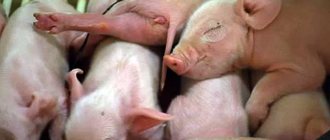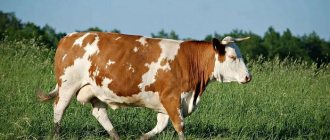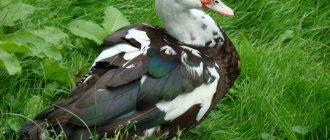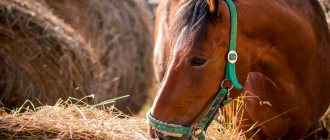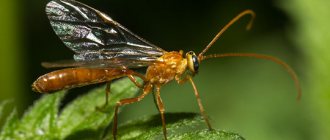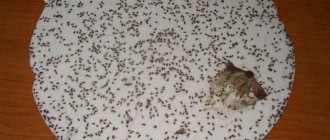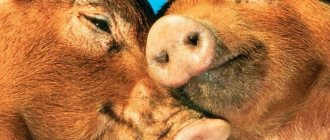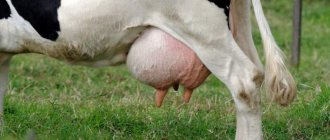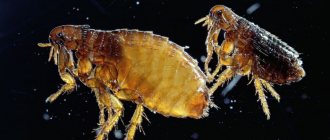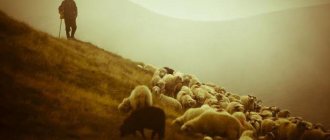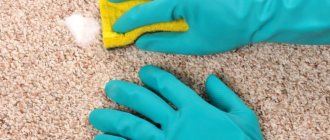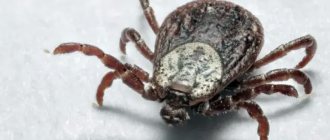Using cow conformation assessment in practice
To determine a highly productive animal, assessing its exterior type is of great importance, since the form and function of the body are closely related. Evaluation of the exterior of cows, despite its well-known subjectivity and conventionality, occupies an important place in dairy cattle breeding. Visual assessment of animals based on their exterior has been known since ancient times. It arose from practical needs and was the first attempt to give an economic assessment of animals based on their appearance.
Breeds of dairy cows have characteristic features - they are not prone to obesity, are able to digest large amounts of rough, juicy and green feed, converting their energy into milk, have thinner, more elastic skin, strong bones, poorly developed muscles, highly developed digestive organs and lungs.
It is known that in herds there are practically no absolutely identical cows that would not have any, even isolated, physique defects. Exterior serves as an aid in the selection of healthy, highly productive, long-term cows. Some conformation traits are directly and indirectly related to productivity, duration of use, suitability for machine milking and maintenance of healthy udders.
The type of dairy cow that one should strive for when organizing breeding activities in a herd was developed by American breeder-designers of the Holstein cow breed. It is this type that ensures high milk productivity while maintaining animal health during intensive use and can serve as a model for dairy cows in our country (D.V. Karlikov, 1995).
In the conditions of Rossiya LLC, Baltachevsky district of the Republic of Bashkortostan, an assessment of the exterior of 440 cows was carried out. The appearance of animals on the farm was assessed on a 10-point scale at 2-3 months of the first and third lactation, 1-1.5 hours before milking. At the same time, 7 main measurements were taken from each animal. To take measurements, a measuring tape and ruler were required, as well as pre-prepared journals for recording the measurements taken.
The procedure for taking measurements of cows is as follows. Animals are placed on a smooth, level area, straight, without bending their legs, back or head. Then measurements are taken with appropriate instruments.
Measurements of cows, which are made with a measuring ruler:
- height at the withers - from the base of the platform (ground) to the top point of the withers;
- oblique length of the body - from the anterior protrusion of the glenohumeral joint to the outer protrusion of the ischial tuberosity;
- chest depth - stepping back a palm from the shoulder blade vertically from the top of the withers to the bottom of the chest;
- chest width - a palm distance from the shoulder blade horizontally between the lateral protrusions of the chest;
- width in maklok – the distance between the side points of the maklok.
The following exterior parameters of cows are measured with a measuring tape:
- girth of the chest behind the shoulder blades - stepping back a palm from the shoulder blade around the chest;
- metacarpal girth - below the hock joint in the thinnest part of the metacarpal bone.
Visual assessment showed insufficient typification of the herd, especially in the udder (Table 1).
The coefficient of variation in udder assessment for first-calf heifers was 12.4% with limits from 3.5 to 5.0 points, and slightly lower for adult animals - 10.8% with the same limits. The gentle, dense type of constitution with a pronounced milk triangle (8 points and above) inherent in the black-and-white breed of cows was present in 142 (71%) of the adult cows among the examined animals, and among first-calf heifers, respectively, 93 (74%) cows. Table 1. Evaluation of cows’ exterior, points.
| Indicators | M+m | Cv, % | Lim |
| 1st lactation | |||
| General appearance and development | 2,3+0,03 | 9,4 | 2,0-3,0 |
| Udder | 3,6+0,05 | 12,4 | 3,5-5,0 |
| Legs | 1,9+0,01 | 7,3 | 1,5-2,0 |
| Sum | 7,8+0,03 | 4,0 | 7,0-9,5 |
| 3rd lactation and older | |||
| General appearance and development | 2,4+0,03 | 7,7 | 2,0-3,0 |
| Udder | 3,8+0,04 | 10,8 | 3,5-5,0 |
| Legs | 1,9+0,01 | 9,3 | 1,5-2,0 |
| Sum | 8,1+0,04 | 3,4 | 7,5-9,5 |
Animals of the model type, which may be of interest as cows of the bull-producing group, among cows with an exterior score of 9.0 points and above and with milk productivity above 5500 kg, there were 16 animals, for example:
- Chulpan-104 had a milk yield of 6189 kg of milk with a fat content of 3.66% with a live weight of 547 kg;
- Volga-1233 - milk yield 5868 kg, fat content 3.66%, live weight 540 kg;
- Violet 407 - milk yield 5777 kg, fat content 3.66%, live weight 548 kg;
- Marta-407 – milk yield 5677 kg, fat content 3.66%, live weight 549 kg;
- Margarita-2 – milk yield 5824 kg, fat content 3.61%, live weight 551 kg;
- Button-236 – milk yield 5580 kg, fat content 3.72%, live weight 555 kg; and others.
The most common defects of the exterior include, first of all, those that are caused by the underdevelopment of animals: low stature and live weight, as well as leg defects, which are expressed in weak pasterns and x-shaped appearance. There were cows with atrophy of one lobe of the udder (3 teats) as a consequence of mastitis. The underdevelopment of cows is primarily due to the lack of targeted rearing of replacement heifers. The imbalance of diets for individual nutritional elements of cows of different ages remains a problem to this day.
Analysis of cattle measurements confirms the results of the visual assessment (Table 2).
Low average values for items with wide limits of fluctuations indicate the heterogeneity of the herd and the need for targeted work to improve the appearance of animals. Table 2. Cow measurements, see.
| Indicators | M+m | Cv, % | Lim |
| 1st lactation | |||
| Height at withers | 125+1,1 | 10,4 | 119-134 |
| Chest depth | 70+0,7 | 9,5 | 64-77 |
| Chest Width | 39+0,5 | 10,4 | 30-44 |
| Width in macrolocks | 50+0,3 | 6,2 | 40-54 |
| Oblique torso length | 159+1,3 | 11,2 | 130-169 |
| Bust | 175+1,7 | 13,4 | 159-197 |
| Pastern girth | 18,1+0,05 | 5,5 | 16-19 |
| 3rd lactation and older | |||
| Height at withers | 127+0,9 | 9,6 | 119-138 |
| Chest depth | 73+0,4 | 9,7 | 67-80 |
| Chest Width | 40+0,3 | 6,5 | 34-49 |
| Width in macrolocks | 52+0,3 | 5,4 | 45-63 |
| Oblique torso length | 162+1,9 | 13,8 | 141-188 |
| Bust | 187+2,0 | 10,3 | 160-206 |
| Pastern girth | 18,9+0,07 | 4,2 | 17-20 |
In the future, the livestock breeder of the farm must regularly carry out strict culling of first-calf heifers newly introduced into the herd based on an assessment of their exterior and productive indicators. This event will allow creating a uniform herd of cows, increasing their milk productivity and the duration of economic use.
When characterizing the desired exterior type of full-aged cows, we were guided by data from breeding farms in the Ural zone and by the indicators of the best cows of the Rossiya LLC herd. Distinctive features of such animals are:
- delicate dense constitution;
- height at the withers – 135-138 cm;
- live weight of the cow – 580-620 kg;
- elongated body with somewhat angular shapes;
- straight back and lower back;
- wide, long and straight rear;
- deep chest with obliquely set ribs;
- voluminous but not saggy belly;
- light elongated head;
- thin, elastic skin with small folds on the neck;
- moderately developed muscles;
- a large, glandular, bath- and cup-shaped udder, well attached to the abdominal wall, with a pronounced furrow 2-3 cm deep and an index of uniformity of development of at least 43%;
- nipples are cylindrical and slightly conical, 5-6 cm long and 2-3 cm in diameter, located at the corners of a square with a side of 12-18 cm;
- strong, correctly positioned legs with a strong hoof horn;
- The milk production rate of cows should be 1.8-2.0 kg/min with a milking duration of no more than 6-7 minutes.
A balanced, strong type of nervous activity is also desirable, capable of withstanding stress factors and promoting non-aggressive behavior of the cow in the group.
Yumaguzin I.F., Candidate of Agricultural Sciences, Head of the Department of Dairy Animal Husbandry; Ardashirov S.S., senior researcher at the dairy cattle breeding laboratory, Federal State Budgetary Institution BNIISKH. 01/01/2015
Visual assessment method
The essence of this method comes down to the fact that the inspector of the farm “by eye” determines the physique features of a particular animal. To do this, he will need extensive experience in breeding cows, since it is necessary to compare the parameters of the animal with the standards for a given breed, taking into account all possible defects of the exterior. Since this method is subjective in nature, it is rather intermediate between the main measurements for preventive monitoring of the condition of animals.
Graph method
The graphical method allows you to draw up an ester profile of the animal, which shows the slightest deviations from the standards for a particular breed. The exterior profile has the form of a graph on which index or measurement data is displayed as dots and connected by lines. Using the graphical method, you can compare bulls and cows from the same breed.
How to determine the age of a cow
The age of an animal can be determined by its teeth, and in cows, by its horns. The calf is born with small teeth at the front of its lower jaw. Sometimes there are 4 of these first teeth, or 6 or 8. If there are fewer than 8 teeth, then very soon after birth the calf grows all the required 8 teeth. These first teeth are called baby teeth and subsequently fall out and are replaced by permanent teeth. All teeth are divided into incisors and molars. The first ones sit only in the lower jaw in front and can be examined by retracting the lower lip, if at the same time holding the animal’s head with the left hand in the nostrils. The molars sit on the sides of the jaws at the top and bottom. The number of incisors is exactly 8 or, distributing them to the left and right half of the mouth, 4 on each side. The number of indigenous people is 24, i.e. in each half of the lower and upper jaw there are 6.
Here, above the line are the teeth of the upper jaw, and below the line are the teeth of the lower jaw. The transverse line divides the teeth into those belonging to the left and right halves of the mouth. The incisors are written in the middle, and the molars are written further from the middle. Molars are written not with one number - 6, but with two - 3. This means that the 3 teeth closest to the middle grow first as milk teeth, and then are replaced, and the last 3 grow immediately as permanent ones. The total number of teeth in cattle is 32.
The age of animals can be determined by the change of primary incisors to permanent ones. The deciduous incisors are small, and the permanent incisors are wide at the time of their appearance, so that these teeth are not difficult to distinguish.
First of all, the central teeth, called toes, are replaced. At the age of about 1.5 years, the milk hooks are replaced by permanent ones. A year after this, i.e. at the age of 2.5 years, the second pair of incisors, called internal middle ones, is replaced. After another year, the next pair is replaced - the outer middle ones, and at 4 or 4.5 years the last pair of incisors - the edges - is replaced. These deadlines can be moved, i.e. the change can occur earlier or a little later, it depends on how well-nourished the animal is and how quickly it grows. After the change of teeth is completed, the teeth gradually wear away and their size decreases. At an older age, for example, 10 years, the teeth no longer stand tightly together, touching each other, and there are gaps between them.
Evaluation by measurements
Visual inspection of animals is carried out very often on farms and at various exhibitions. But sometimes there is a need to more accurately determine the breed data of an individual and its potential in terms of productivity. For example, a simple visual inspection is often not enough when selecting livestock for breeding. Large farms often create sperm banks for cattle, small cattle, pigs and other possible highly productive breeds. In this case, subjective errors are, of course, absolutely unacceptable.
That is why the assessment of the exterior of farm animals when selecting them for breeding is most often carried out with additional measurements.
Research of this type is regulated by regulations. There are a total of 70 different measurements. For example, when determining the degree of breed of an animal, the following can be measured:
- height of the animal at the withers;
- in back;
- in the sacrum;
- skin thickness, etc.
Evaluation by indexes and profiles
Sometimes, when conducting research on animals for potential productivity, knowing the length of its limbs, height at the withers, etc. is not enough. In this case, among other things, the relationships of these parameters in relation to each other are determined. The proportionality of the physique of animals is assessed using indices. The ratio of one measurement to another is expressed as a percentage. At the final stage, the obtained indicators are compared with data from the standards tables.
Assessment of the constitution and exterior of farm animals using profiles is carried out approximately according to the same principle. But in this case, it is carried out not for one individual, but for a group.
How to determine the fatness of a cow
The condition of livestock can be determined by feeling its skin. In a well-nourished animal, the skin can be pulled back and a more or less thick, pasty layer can be felt. In a strong state of nutrition, this subcutaneous layer is filled with fat, and then the skin forms entire pillows in places. This can be especially noticeable at the base or root of the tail. In a less strongly fattened state of the animal, you can still notice good fatness by feeling the fold of skin in the groin. If the skin cannot be pulled into a fold, and it seems to have dried to the body, then this indicates the hungry state of the animal. In this state, all the bones of the animal stand out sharply, and the meat or muscles located on the sides of the sacrum are greatly reduced, so that more or less sharp depressions are obtained on the body of the animal. A hungry animal does not complete its spring molt for a long time and has coarse, dry hair.
You can judge by its appearance what kind of care the animal received. If an adult animal appears skinny and flat-ribed, it is very likely that it received very little food in its youth.
If an adult cow is very small for her age and breed, then she was probably covered too early the first time and calved early. Such a small cow is called in the Yaroslavl province. “knee”, and unusually large, which became so as a result of late covering, “transitioning”. Finally, if the cow is dirty with a layer of manure built up on its belly and legs, making noise when moving, then this clearly indicates that the owner is not cleaning the cow. Lack of cleaning of the cow leads to a decrease in milk yield.
A conclusion can be drawn about the temperament or disposition of an animal by how it behaves when a stranger approaches, even if this person did not intend to cause him any trouble. An animal of good disposition, not alert, stands calmly or even trustingly approaches a person and sniffs him. The angry bull lowers his head, rolls his eyes, roars and digs up the ground with his front legs. Eorovs do not exhibit such drastic phenomena, but still, when they have a bad temper and the approach of a stranger, they lower their heads or shake their heads, and when they touch the body, especially the udder, they kick their hind legs forward. The restless and angry disposition of an animal, of course, makes it difficult to care for it, and therefore animals with such a disposition are undesirable in the household.
It turns out that an animal has such a disposition mostly due to its improper upbringing in youth and cruel treatment of it in adulthood.
Constitution of a cow
The height and physique of the animal is determined using measurements. The so-called constitution of animals can be determined by their physique. There are several types of constitution - rough, strong, tender, overdeveloped, dry, damp. The first four types of constitution characterize the health and productivity of the animal, and the last two types characterize the actual relationship between the bones of the animal on the one hand and the muscles and skin on the other. Animals with a rough constitution are distinguished by good health and endurance, but at the same time, these animals are extremely late-ripening and unproductive, especially in dairy and meat production. Animals with an overdeveloped constitution have the opposite properties. They are extremely delicate in terms of health, but have enormous productivity in milk and meat. Between these two extreme types are animals with a strong and delicate constitution. Working animals need a strong constitution and a rough one is acceptable. A delicate or overdeveloped constitution is suitable for dairy and meat animals, but if the animals are to serve as breeding animals, then an overdeveloped constitution is not suitable. However, overdeveloped animals may be suitable for purposes of use, not breeding, i.e. in the event that the animal is not required to produce offspring, but only milk yield is needed, or the animal is fattened for slaughter. Meat animals must have a raw constitution. For dairy animals, a dry constitution is more suitable, but if meat and dairy cattle are bred, then the constitution should be between these extreme types. The same can be said about the exterior of working animals, where a combination of strong bones and thick but dry skin and abundant muscle development are necessary.
Cow weight
The weight of the animal is important because it gives some idea of the animal's productivity and even more about their needs! A cow weighing 40 pounds will require significantly more feed than a 25-pound cow; heavy cattle, in general, produce more meat, more pulling power, and sometimes more milk.
Cow horns
The shape and size of the horns are related to the breed, age and age of the animal. Each breed has its own characteristic horns. The horns of bulls are shorter, but thicker than those of cows and are directed more to the sides. In oxen, the horns take the same direction as in cows, but grow more in length.
Cow leather
Animal skin varies in thickness, roughness or softness, elasticity and lubrication with sebum . The latter applies even more to wool. The fur itself can be coarse or soft, long or short. All of the listed signs are related to the sex of the animals, their age, breed, productivity, climate and health status of the animals. The quality of the skin is determined by touch and most of all around the last rib.
The individual parts of the animal’s body or its “stats” listed above characterize for the most part the qualities of the animal given to it by nature. You can't change much about them. But perhaps, in addition, there is another assessment of the appearance of the animal, namely: an assessment of the state in which the animal is in question. For example, if we consider a cow in the dairy period and then the same cow when it is intended for marriage and put on fattening, then although the animal’s constitution and its constitution remain the same, the condition of the animal has changed greatly. In the first case, we had a cow in the state of a breeding animal, in a breeding body, and in the second, in a state of fattening. Or, for example, the same bull can be presented in two states—at the beginning of the breeding period and after this period. Usually, after the breeding period, a bull is very tired, but at first it is fresh and well-fed.
Scoring method (linear method)
This method consists of assigning points (from 1 to 9) to each of the 19 main body parameters, which indicate the degree of its severity. In this case, deviations from the norm are also taken into account (a + or - sign is placed). Next, the points are summed up and based on the result obtained, the class of the animal can be determined. Depending on the number of points, the following groups are distinguished:
- 90 points – especially valuable specimens;
- 85–89 points – elite record holders;
- 80–84 points – elite;
- 75–79 points – 1st grade;
- 70–74 points – 2nd grade;
- Up to 69 points are not great.
What is the visual method?
This technology is most often used when assessing the exterior of animals. In this case, specialists simply carefully examine the features (limbs, tail, back, withers, etc.) of the tested individual. Also, during a visual assessment, the animal’s compliance with standards in terms of body proportionality is determined.
Only experienced specialists with a trained eye can carry out an inspection using this technique. The advantage of this technology is primarily the speed and ease of assessment. Its disadvantages primarily include the element of subjectivity.
